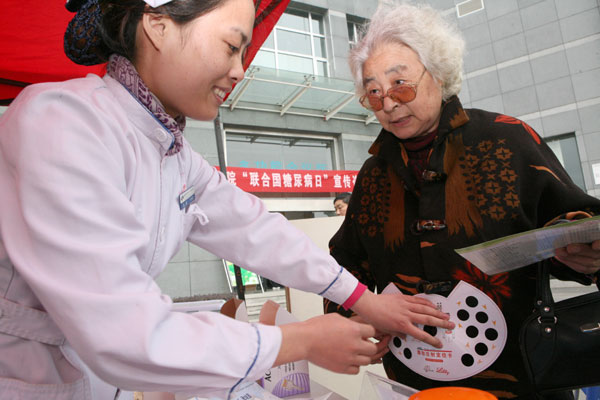Lack of diagnosis hampers efforts
Updated: 2012-11-14 03:01
By SHAN JUAN (China Daily)
|
||||||||
Only 40 percent of China's estimated 92 million diabetes patients get diagnosed, which seriously undermines early treatment for sufferers and the nation's overall intervention efficiency, a leading specialist warned.
Ji Linong, president of the Chinese Diabetes Society under the Chinese Medical Association, made the remarks at an event on Tuesday to mark World Diabetes Day, which falls on Nov 14 every year.
 |
|
A nurse shows a diabetic where on her body to inject insulin, at the Xiangyang No 1 People's Hospital in Hubei province in November 2011. GONG BO / FOR CHINA DAILY |
According to Ji, the number of diabetes patients on the mainland has doubled over the past decade, and about 9.7 percent of the population aged 20 and older suffer from the chronic disease related to a high-fat diet and sedentary lifestyle.
"Early detection and treatment could well avert or delay the development of complications and help lower treatment costs," Ji said.
Diabetics who do not receive early treatment could suffer a heart attack, kidney failure or serious complications that result in amputation, he said.
Ji attributed the low diagnosis rate to limited access to early screening services and poor public awareness.
"The later the patient begins with treatment, the more costly it would be," said Kong Lingzhi, deputy director of the disease prevention and control bureau under the Ministry of Health.
Statistics from the ministry showed that more than 5 percent of China's total health expenditures went to diabetes treatment.
Roughly 60 percent of Chinese patients take an oral medication and the rest a combination of insulin injections and oral medications, statistics from the Chinese Diabetes Society showed.
Ji said that around 60 percent of patients suffer complications of various severity.
According to Ji, 80 percent of the mainland's annual diabetes treatment costs are for complications, which involve a lot of inpatient care.
"A poor control of blood-sugar level is mainly to be blamed," he said.
Less than half of diabetics manage to keep their blood-sugar levels under control, he added.
Kong said health authorities will enhance diabetes control efforts, particularly at grassroots-level health facilities.
By 2030, China will have 40 million new diabetes cases on the mainland, and the treatment cost for all patients will reach about $28 billion annually, the International Diabetes Federation estimated.
The latest report from the Beijing municipal government on residents' health showed that 8.9 percent of locals between the ages of 18 and 79 have diabetes, up 0.3 percent over 2008.
Some 10.3 percent of males in the age bracket have the disease, and the number for women is 7.4 percent, according to the report.
The rate increases as people age, experts said.
Among residents between the ages of 18 and 29, the diabetes prevalence is 1.3 percent, which is the lowest of all age groups. The highest rate — 24 percent — was found in people older than 70, the report showed.
However, overweight and obese children are at high risk of the condition as well, Ji said. "Childhood diabetes will seriously impact the sufferer's future education and employment, and the nation's development as a whole."
Contact the writer at Shanjuan@chinadaily.com.cn

 Relief reaches isolated village
Relief reaches isolated village
 Rainfall poses new threats to quake-hit region
Rainfall poses new threats to quake-hit region
 Funerals begin for Boston bombing victims
Funerals begin for Boston bombing victims
 Quake takeaway from China's Air Force
Quake takeaway from China's Air Force
 Obama celebrates young inventors at science fair
Obama celebrates young inventors at science fair
 Earth Day marked around the world
Earth Day marked around the world
 Volunteer team helping students find sense of normalcy
Volunteer team helping students find sense of normalcy
 Ethnic groups quick to join rescue efforts
Ethnic groups quick to join rescue efforts
Most Viewed
Editor's Picks

|

|

|

|

|

|
Today's Top News
Health new priority for quake zone
Xi meets US top military officer
Japan's boats driven out of Diaoyu
China mulls online shopping legislation
Bird flu death toll rises to 22
Putin appoints new ambassador to China
Japanese ships blocked from Diaoyu Islands
Inspired by Guan, more Chinese pick up golf
US Weekly

|

|






